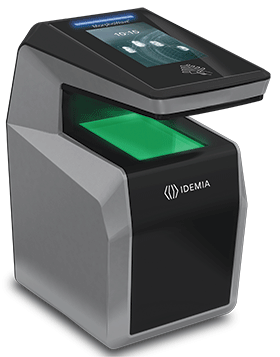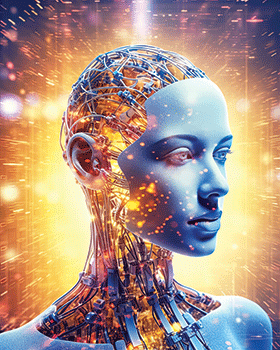
Artificial intelligence (AI) has a very real impact on contemporary society, and we have only just begun to reap the benefits, and tackle the associated challenges. AI technology use cases have become more mainstream as deep learning algorithms help us to solve increasingly complex problems.
Applied to the fields of identity and security, these technologies have driven massive progress over the last decade – progress that would not have been possible without human supervision.
What AI is… and what it is not
AI technologies: separating myths from reality
Let us be clear about one important distinction. AI allows a machine to learn on its own, but it cannot train a machine to think on its own. So, what exactly do we mean by intelligence? If we go back to its Latin root, intelligence is the ability to understand, an ability that is unique to humans and inseparable from their capacity to think. As unsettling as the performance of certain recent AI applications may be, we should be careful not to jump to the conclusion that human intelligence and artificial intelligence are one and the same.
The term ‘artificial intelligence’ dates back to the 1950s, when experts were captivated by the rapid progress of computers. For decades, what passed for ‘intelligent machines’ were, in fact, elaborate computer programs that enabled computers to perform pre-programmed tasks, such as playing chess. Although they were groundbreaking at the time, these computers were still far from being sources of true intelligence – or understanding.
Today, AI technologies learn by trawling through reams of data and drawing conclusions based on recurring patterns. In this way, they provide humans with insights, but they still lack the ability to think – and understand – their own conclusions.
In order to learn and draw conclusions, machines use an algorithm (i.e., a step-by-step guide) to complete a precise task, within a predefined framework, and to meet a specific need. To be a genuine source of understanding (and intelligence), this learning can only be achieved in partnership with humans – never by machines alone.
Ultimately, the true source of intelligence remains human. Human intelligence first understands the problem to be solved and designs the framework to do this. It is also human intelligence that is subsequently able to draw lessons from the learning process and the findings generated by the machine. In actual fact, artificial intelligence is really an extension of human intelligence rather than a form of intelligence in itself.
In short, AI technologies are a fantastic tool for assisting human intelligence. They pave the way for automation and faster decision-making, but human supervision is, and will always be, indispensable.
The technology behind the concept
Machine learning is the core technology behind AI. It consists of teaching computers to autonomously find information within sets of data. Once a machine is given an example, it can sift through data to find patterns and correlations based on what it learned. When a machine starts drawing the right conclusions, it can then apply these learnings to new sets of data. The algorithm adapts and improves over time as it processes more data.
Deep learning, on the other hand, is a subset of machine learning. It mimics the neural network architecture of the human brain. Unlike machine learning, deep learning neural networks rely on several processing layers (that is where the “deep” comes from) to identify patterns, classify information or recognise speech, images, etc. Rather than relying on an example, deep learning algorithms process incredible quantities of raw data to learn and improve.
The deep learning paradigm shift
Deep learning algorithms have allowed AI technologies to penetrate countless markets and industries in recent years. Today, you would be hard-pressed to find a sector – or even a person – that does not rely on AI solutions for some aspect of their business or everyday life. But what sparked this uptick? In large part, our own consumer habits have pushed deep learning to the forefront.
Connected devices, smart cities, IoT in general, and our online habits – all these technological advancements produce an abundance of granular data from an incredibly diverse pool of sources. This large amount of data, paired with a marked increase in computer power, which began in the 1980s; more advanced algorithms and technology that became sufficiently mature in the early 2010s; ushered in a more efficient way of learning.
The ability to sort through massive amounts of data, brought by deep learning, exponentially boosts performance. Problems can now be modelled with millions of parameters, deepening the learning process and providing answers to problems more complex than ever before. Carrying out tasks such as recognising shapes or understanding speech has become amazingly efficient, boosting entire domains in the process.

Why are today’s AI algorithms so efficient?
The power of deep learning technology
Humans can often become overwhelmed by colossal volumes of data and, alone, are only able to exploit a finite portion, leaving large pools of data unused. Deep learning technology, on the other hand, is hugely scalable. By design, deep learning’s neural network becomes more efficient with the addition of new neurons. This means that machines can absorb a limitless amount of new data.
Instead of reaching saturation, waves of data actually improve performance. As the network grows, performance increases and models become able to handle more complex problems. Deep learning is also an iterative process – meaning it is a dynamic, self-actualising system that continuously adjusts to new data to find a better answer. This is yet another way that deep learning mimics the human mind. Like us, deep learning algorithms improve with experience, but the comparison ends there.
The importance of (precise) data
Deep learning technology requires tons of data; the larger the datasheet, the better. But not just any data. Data collection must be precise and error-free to ensure the results are correct and unbiased. It also needs to be relevant, meaning that data must be sourced without losing sight of the problem. In other words, it is necessary to understand the applications in order to develop technological tools accordingly.
The importance of data has skyrocketed in recent years, making it a true competitive advantage for those who source and use it properly. That last part is essential. Data is, above all, a precious resource that must be safeguarded. That means that a clear framework concerning the ethics behind the ways in which data is gathered, stored and used is of utmost importance, especially considering how the use of data has evolved and will continue to evolve over the years.
How does deep learning boost identity and security technologies?
Biometrics
Advancements in AI have revolutionised the field of biometrics. The ability to model more complex problems and process more data much faster has raised the bar substantially in terms of performance and accuracy.
For starters, the sheer amount of data available combined with the computing capabilities brought about by deep learning make biometric algorithms more accurate than ever before. While facial recognition is perhaps the best example of the impact AI has on biometrics, deep learning has also driven advancements in fingerprint technology, and is just starting to scratch the surface in the realm of iris technology as well.
In the early days of facial recognition algorithms, it was only possible to identify a face when positioned directly in front of a biometric terminal. Progress in this field, mainly driven by AI increasing efficiency, has improved the user experience.
Today’s AI facial recognition technology requires very little of the user while their identity is verified; the process is faster, more efficient and frictionless. For example, a user’s face can be accurately analysed whether they are moving or static, wearing glasses or smiling, facing the biometric terminal or looking in another direction. AI algorithms can even achieve liveness detection without asking the subject to perform any specific pose or movement. Liveness detection – or the ability to confirm that the analysed face or fingerprint is, in fact, actually presented, in person, by their real owner (versus a photo, silicone mask or a spoofed fingerprint) drastically improves anti-fraud systems.
When it comes to fingerprint biometrics, deep learning technology makes it possible to read even damaged fingerprints or accurately verify identity via a fully contactless access control system.
Frictionless access control
Today’s access control systems can also rely on facial biometric data to identify visitors and employees from a distance as they enter a building. Advanced algorithms can create a truly seamless biometric identification experience by enabling in-motion recognition, while ensuring the highest accuracy. The strength behind this technology resides in the ability of AI algorithms to analyse the entire situation around access points, enabling group access and detecting suspicious behaviours simultaneously.
As the world in general veers more towards contactless methods, so does the field of access control. Using an AI facial recognition system means no direct contact is needed with access control equipment, a much more hygienic alternative in a post-pandemic climate.

Document authentication
Another real-world example of deep learning technology at work is the verification of a vast array of documents – including passports, driver’s licences, visas, immigration papers, tax documents, voter identification cards and more. Deep learning algorithms can detect documents placed on a scanner or in front of a phone camera; identify the type of document, the person is who they say they are – all within a few seconds.
Smart data analytics for enhanced safety
While the legal framework concerning the use of AI to ensure public safety raises legitimate ethical questions around the world – and will continue to evolve, AI solutions have been and will continue to be incredibly useful in very precise situations. First, in identifying victims of crimes; second, in searching for people convicted or suspected of serious offences; and lastly, in the event of a serious or immediate public safety threat. In these situations, AI can be used to automatically extract faces, vehicles or other objects that appear in video footage and send automated alerts when found. It makes sense of all available data; saves time, resources and money – all while reducing human error.
What’s next for identity and security technologies?
With the technology wave continuing to swell, it is safe to say that data volumes will only continue to grow exponentially. That means that a sizable amount of unlabelled data is being created every second of every day – data that is not yet being used to its full potential. This shift in data volumes will most certainly continue to power AI models and use cases in the future.
The shift on the horizon is the move from supervised (using labelled data only) to semi-supervised learning (using labelled data and unlabelled data), weakly-supervised (using indirect labels) or even unsupervised learning (using only unlabelled data). These techniques allow for increased data usage even when labels are unavailable or too difficult to produce. But let us be clear, whether the data is labelled or not, the learning process – and the measurement of its performances – will remain under human supervision.
We are starting to understand what goes on inside neural networks, a process that will continue to advance in the years to come. Today, AI experts are looking further into how deep learning algorithms reach the conclusions that they do, particularly when they do not reach the expected result. That said, it is important to remember that while an algorithm allows a machine to learn on its own, it is also backed by an industrial process. Humans still have the extremely important task of validating, testing, measuring results and doing whatever it takes to ensure algorithm accuracy. We humans cannot simply develop the technology and ‘let it loose’.

IDEMIA’s commitments when working with AI technologies
At IDEMIA, AI is not just a tool to analyse business data or optimise logistics as in many other companies. It is at the core of the solutions we develop. More precisely, we use it to enable our systems to derive meaningful information from visual inputs and act or make recommendations accordingly.
First and foremost, IDEMIA recognises the sensitive nature of all personal data. We are committed to data protection, not only when training AI algorithms and developing solutions, but also when our solutions are used in the field. We consider it absolutely essential to make sure that our solutions cannot be hijacked, tampered with or circumvented. To this end, we pay special attention to how data is handled and the applicable regulations. In fact, long before GDPR regulation existed, we had set up our own processes and infrastructure to securely manage personal data – these processes are now also in compliance with privacy regulations such as GDPR in Europe, USA privacy regulations or their equivalent in other regions.
In order to create the most accurate algorithms, we constantly need to access more data, responsibly. We obtain data from clients in compliance with relevant privacy regulations to train their algorithms and provide high-performance products and solutions. We also rely on data shared on a voluntary basis by our employees to build up our database year after year. Lastly, we create synthetic images using a Generative Adversarial Network (GAN). This enables us to generate qualitative synthetic facial images and fingerprints that are completely fictional. So, when a client asks us to share data to test the efficiency of our algorithms, we can share our synthetic data.
As a leader in our field, we are committed to creating solutions that protect personal data and ensure it cannot, and will not be, misused. To do so, we apply our expertise in cryptography techniques and access management rights to design databases in a way that allows authorised users to search a database for a particular person without giving them access to the list of people in that database. That means no one can extract personal data – not IDEMIA, our clients, governments or anyone who may attempt to break in. Furthermore, whenever this is possible, we design solutions and systems to ensure that personal data is held only by their individual owners, encrypted in the secure element of a document, a smartcard or smartphone, for example.
As technology and cryptographic techniques continue to advance, we keep investing in new ways to further protect personal data and ensure restricted access to such data.
For more information, contact IDEMIA, +27 83 622 2333, [email protected], www.idemia.com
This article has been shortened, the full text is available at https://www.idemia.com/insights/why-artificial-intelligence-so-crucial-modern-identity-and-security-technologies (or via the short link: www.securitysa.com/*idemia10).
| Tel: | +27 11 601 5500 |
| Email: | [email protected] |
| www: | www.idemia.com |
| Articles: | More information and articles about IDEMIA |

© Technews Publishing (Pty) Ltd. | All Rights Reserved.